In Ohio, the vibrant world of woodpeckers encompasses diverse species, each contributing uniquely to the state’s ecosystems.
From the striking Pileated Woodpecker to the industrious Hairy Woodpecker, these avian carpenters play crucial roles in pest control, seed dispersal, and habitat diversity.
Ohio has 11 distinct types of woodpeckers, each with a color palette, behavior, and ecological significance.
This exploration will provide a comprehensive overview of these woodpecker species, shedding light on their habitats, distinctive features, and the invaluable contributions they make to Ohio’s natural landscapes.
Join us on a journey to uncover the fascinating world of the 11 types of woodpeckers calling Ohio home. Stay focused.
11 Woodpeckers Of Ohio
Explore Ohio’s diverse woodpecker population, each species bringing unique colors, behaviors, and habitats to the state’s avian landscape.
From the vibrant Red-naped Sapsucker to the adaptable Hairy Woodpecker, discover the fascinating world of these feathered carpenters and their roles in Ohio’s ecosystems.
1. Pileated Woodpecker
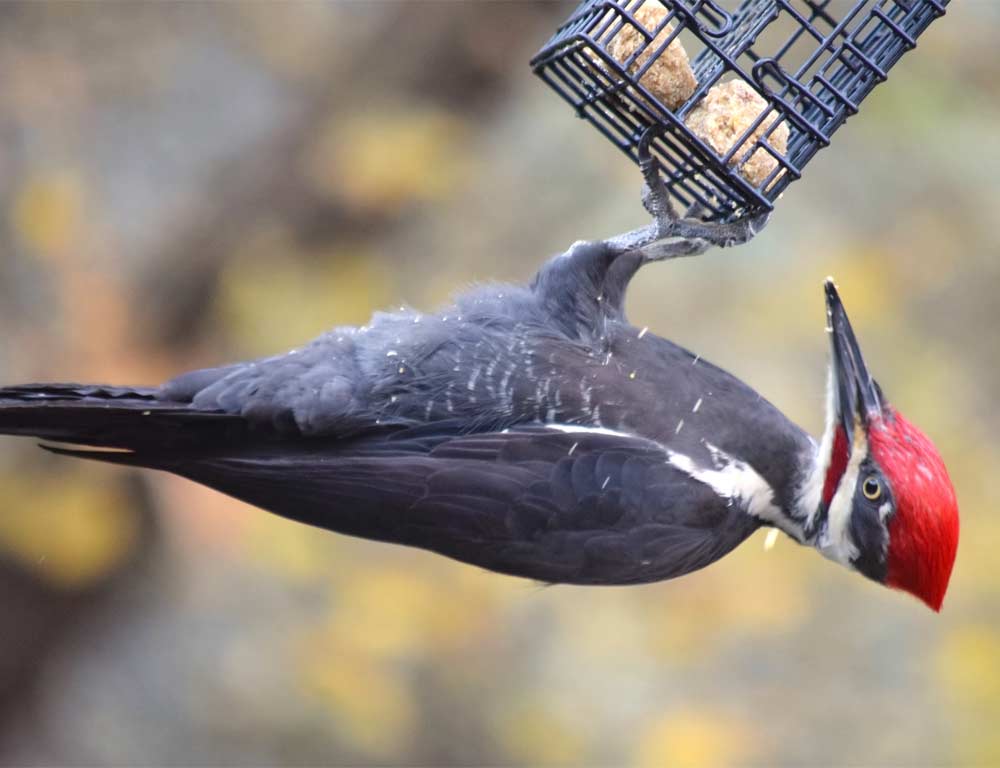
- Scientific name: Dryocopus pileatus
- Life span: Up to 12 years
- Size: 16 to 19 inches
- Weight: 8 to 12 ounces
- Food: Mainly insects, especially carpenter ants, wood-boring beetle larvae; also fruits and nuts.
- Wingspan: 26 to 30 inches
- Status: Stable
The Pileated Woodpecker is a striking bird with its bold black and white plumage and a distinctive red crest on its head. It is the largest woodpecker in the region, found in Ohio’s mature forests.
With strong chisel-like bills, they create rectangular-shaped holes in trees while foraging for insects. Their strong, direct flight and loud, resonant calls make them easy to spot.
Pileated Woodpeckers lead a predominantly sedentary lifestyle, establishing territories that they defend year-round. They are often found in large, undisturbed woodlands and adapted to living in coniferous and deciduous forests.
Nests are excavated in dead trees and have a diverse diet, consuming insects, fruits, and nuts. Their unique drumming and vocalizations contribute to their presence in Ohio’s rich avian tapestry.
2. Downy Woodpecker
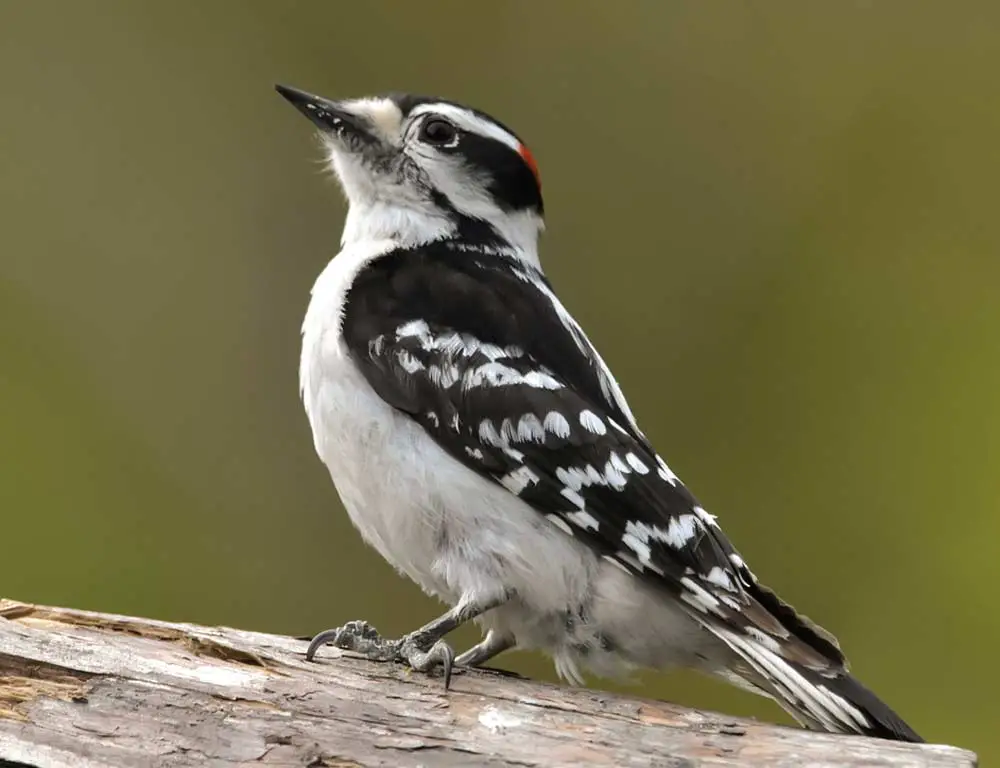
- Scientific name: Dryobates pubescens
- Life span: 4 to 7 years
- Size: 5.5 to 7.1 inches
- Weight: 0.7 to 1 ounce
- Food: Insects, especially beetles and ants, and occasionally seeds.
- Wingspan: 9.8 to 12.2 inches
- Status: Common
The Downy Woodpecker is the smallest and one of the most common woodpeckers in Ohio.
With a distinctive black and white plumage and a small red patch on the back of its head (in males), it is a familiar sight in wooded areas, parks, and even urban neighborhoods.
Downy Woodpeckers lead an active and adaptable lifestyle. They are found in various habitats, from woodlands to suburban gardens, and are well adapted to human presence.
They use their short bills to tap on trees in search of insects and consume seeds. Their drumming and sharp calls are characteristic sounds of the Ohio woods.
3. Red-headed Woodpecker
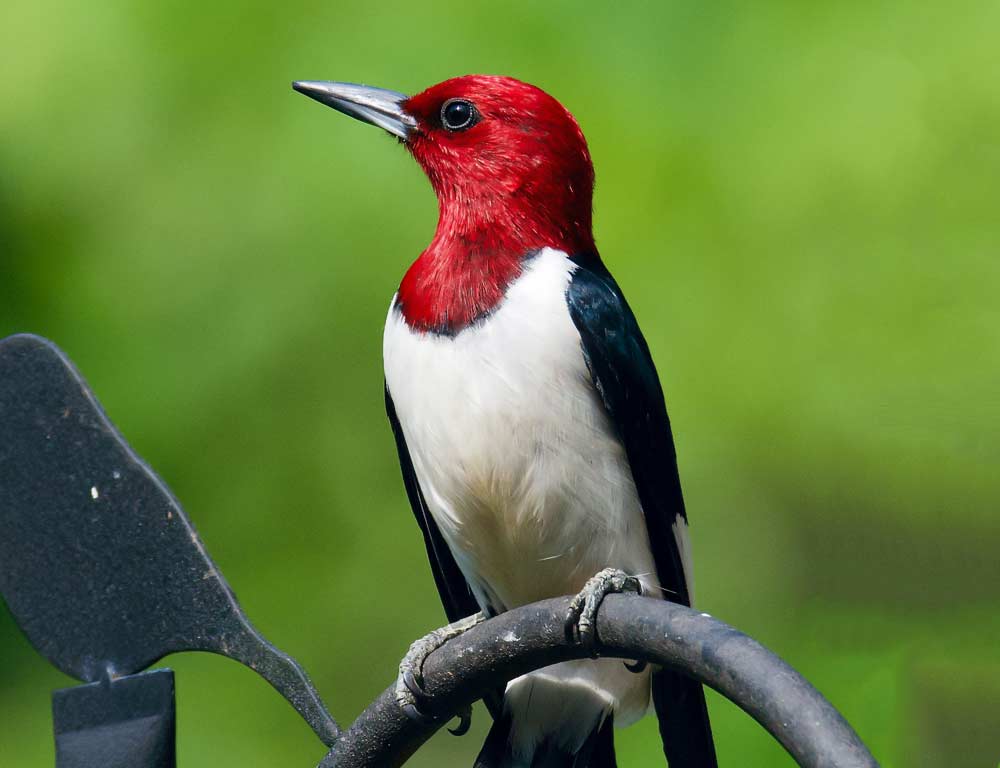
- Scientific name: Melanerpes erythrocephalus
- Life span: Up to 9 years
- Size: 7.5 to 9.1 inches
- Weight: 2 to 3 ounces
- Food: Insects, seeds, nuts, and fruits.
- Wingspan: 16.5 to 17.7 inches
- Status: Declining
The Red-headed Woodpecker is known for its vibrant plumage, featuring a solid red head, black and white wings, and a bright white belly. Once common in Ohio, their populations have declined due to habitat loss and competition for nesting sites.
Red-headed Woodpeckers are versatile foragers, capturing insects in mid-air and storing surplus food in tree crevices or even impaling it on thorns. They prefer open habitats with a mix of woodlands and open areas.
Their strong, direct flight and distinctive calls make them easily recognizable. Conservation efforts are underway to protect their habitat and reverse their declining numbers in Ohio.
4. Red-bellied Woodpecker
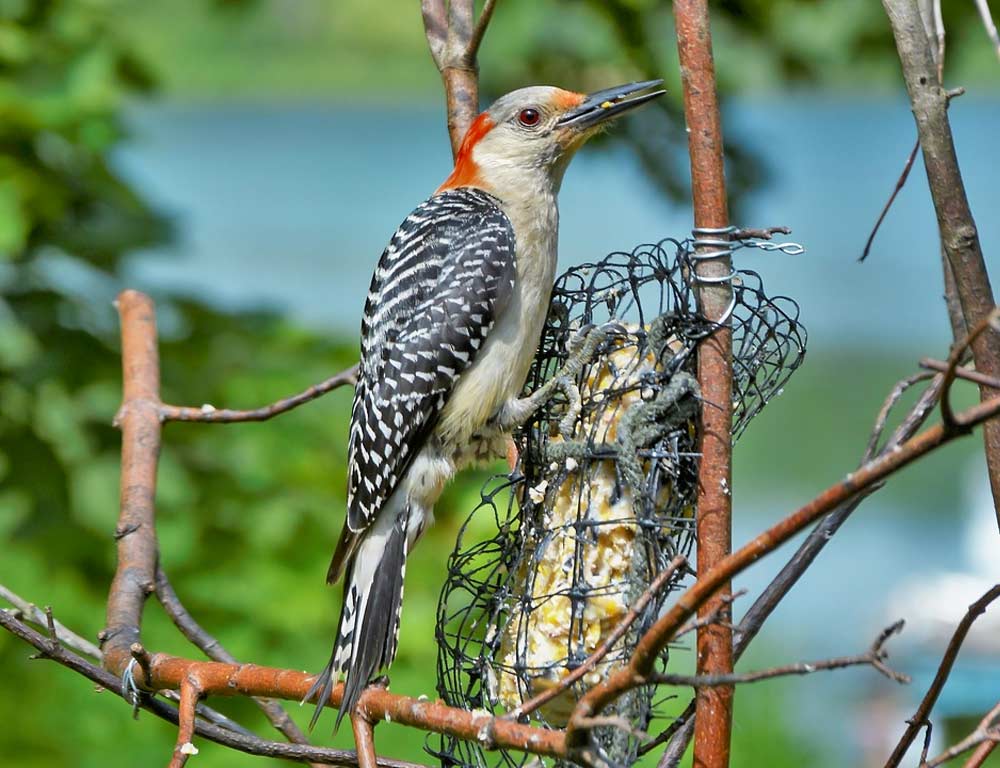
- Scientific name: Melanerpes carolinus
- Life span: Up to 9 years
- Size: 9 to 10.5 inches
- Weight: 2 to 3 ounces
- Food: Insects, fruits, nuts, and seeds.
- Wingspan: 13 to 16 inches
- Status: Common
Despite its name, the Red-bellied Woodpecker has only a faint red tinge on its belly, with the main red coloring found on its head. Its back and wings are marked with black and white stripes.
This adaptable bird is a frequent visitor to backyard feeders and enjoys a varied diet. Red-bellied Woodpeckers are known for their acrobatic foraging habits. They use their strong bills to probe for insects in tree bark and also feed on fruits and nuts.
They are versatile in their habitat, found in both mature forests and suburban areas. Their calls are a mix of chattering and distinctive “churr” sounds.
5. Yellow-bellied Sapsucker
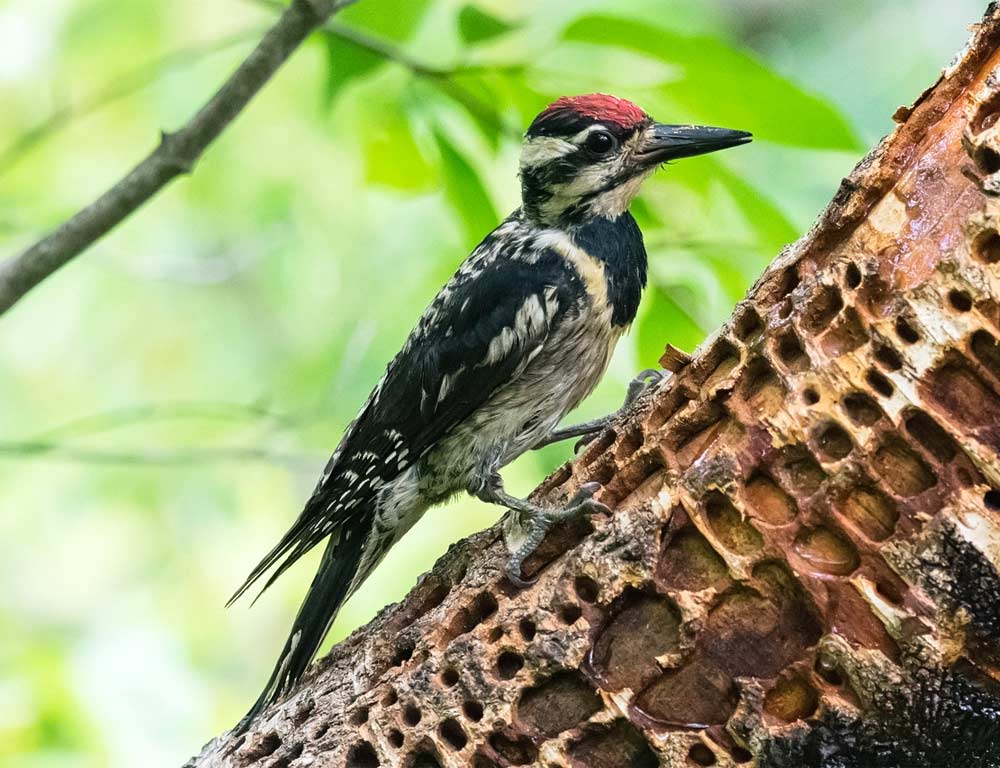
- Scientific name: Sphyrapicus varius
- Life span: 4 to 7 years
- Size: 7.5 to 8.7 inches
- Weight: 1.5 to 2 ounces
- Food: Tree sap, insects attracted to sap wells and fruits.
- Wingspan: 13.4 to 15.8 inches
- Status: Stable
The Yellow-bellied Sapsucker is easily identified by its black and white plumage, red forehead, and, as the name suggests, a yellowish tinge on its belly.
Unlike other woodpeckers, it specializes in feeding on sap by drilling holes in tree bark, creating a characteristic pattern of rows of small holes.
Yellow-bellied Sapsuckers lead a unique lifestyle centered around sap-feeding. They are migratory, breeding in northern forests and wintering in the southeastern United States.
These woodpeckers have been known to drill wells in multiple tree species to feed on sap and the insects it attracts. They also consume fruits and insects, contributing to their overall diet.
6. Northern Flicker
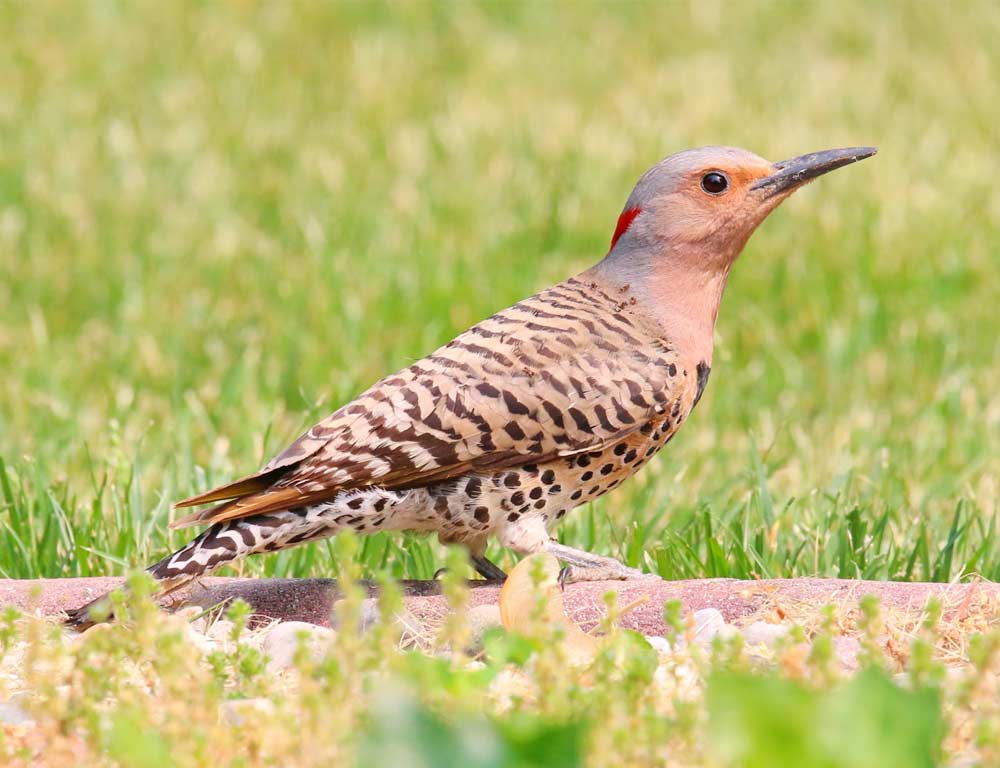
- Scientific name: Colaptes auratus
- Life span: 6 to 7 years
- Size: 11 to 14 inches
- Weight: 3 to 5 ounces
- Food: Insects, especially ants, beetles, and seeds.
- Wingspan: 16.5 to 20 inches
- Status: Common
The Northern Flicker is a distinctive woodpecker with a brown body, a spotted belly, and a striking black crescent on its chest. Its wings have contrasting colors and a unique, undulating flight pattern.
Unlike many woodpeckers, flickers are often found foraging on the ground for ants. Northern Flickers are adaptable birds found in various habitats, from woodlands to urban areas.
They use their slightly curved bills to extract insects from tree bark and also feed on the ground, using their long tongues to capture ants.
Their calls are a series of loud, rhythmic “Wicka” or “killer” sounds. They are cavity nesters, utilizing both natural and abandoned cavities for nesting.
7. Ivory-billed Woodpecker
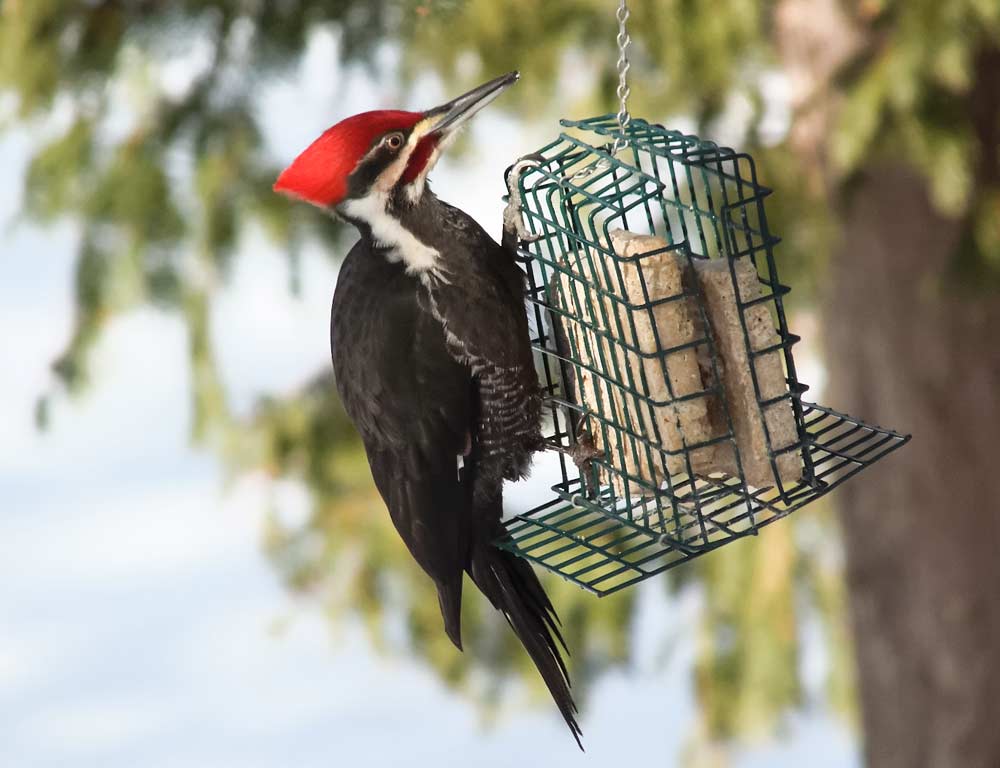
- Scientific name: Campephilus principalis
- Life span: Unknown
- Size: 19 to 20 inches
- Weight: Approximately 1 pound
- Food: Insects, especially beetle larvae and tree-dwelling arthropods.
- Wingspan: 29 to 31 inches
- Status: Critically Endangered (Presumed extinct)
The Ivory-billed Woodpecker, once native to the southeastern United States, is an iconic and possibly extinct species.
With striking black and white plumage, a distinctive ivory-colored bill, and a red crest on the male’s head, it was one of the largest woodpeckers in North America.
The last confirmed sighting was in the 1940s, and extensive efforts to rediscover the species have been unsuccessful, leading to its classification as critically endangered and likely extinct.
The Ivory-billed Woodpecker inhabited bottomland hardwood forests and its decline was primarily due to habitat destruction and logging.
Despite reported sightings and ongoing searches, conclusive evidence of its existence remains elusive. Efforts to preserve potential habitats and conduct comprehensive surveys continue in hopes of finding any remaining individuals.
8. Red-cockaded Woodpecker
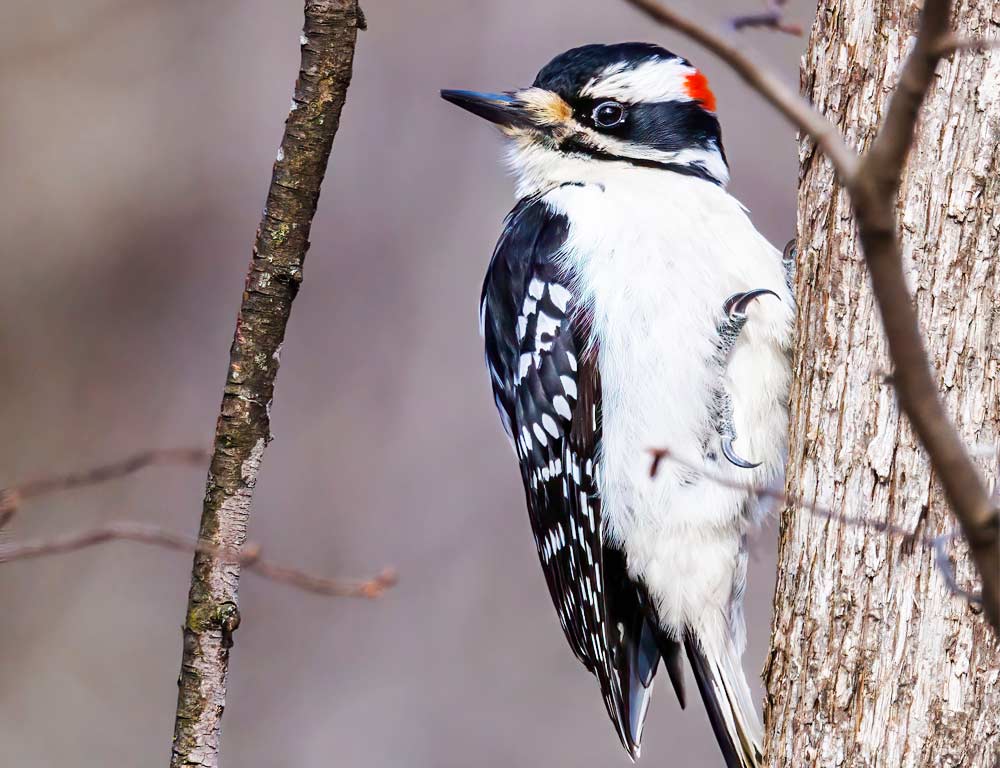
- Scientific name: Leuconotopicus borealis
- Life span: Up to 9 years
- Size: 7 to 9 inches
- Weight: 1 to 1.7 ounces
- Food: Insects, especially ants, beetles, and caterpillars.
- Wingspan: 13 to 16 inches
- Status: Endangered
The Red-cockaded Woodpecker is a small woodpecker with a black and white barred back, a black cap, and distinctive small white cheek patches. The name “red-cockaded” refers to the small red streak on the male’s cheek.
This species is unique in its preference for living in old-growth pine forests and creating cavities in live pine trees.
Red-cockaded Woodpeckers are a cooperative breeding species, with a family group assisting in raising chicks. They have suffered population declines due to habitat loss, primarily from logging and land development.
Conservation efforts involve habitat restoration, controlled burns, and artificial cavity installations to aid their recovery.
The Red-cockaded Woodpecker is listed as endangered, and ongoing conservation initiatives aim to secure its future in the southeastern pine forests.
9. Red-naped Sapsucker
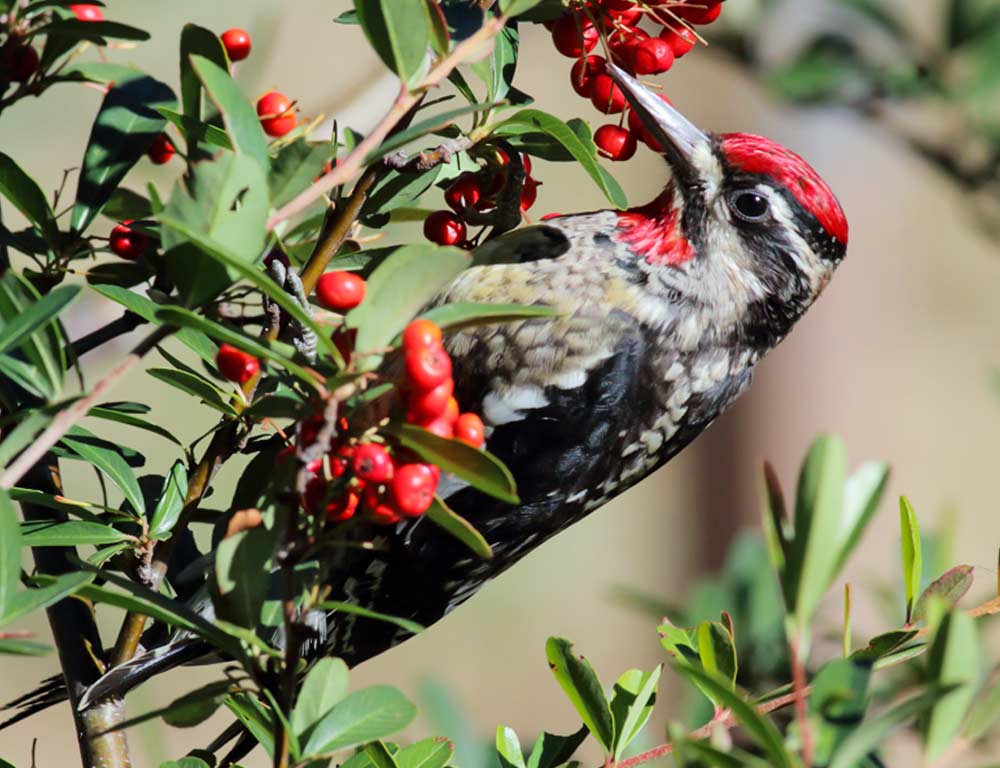
- Scientific name: Sphyrapicus nuchalis
- Life span: 4 to 8 years
- Size: 7 to 8 inches
- Weight: 1.5 to 2 ounces
- Food: Sap, insects, and occasionally fruits.
- Wingspan: 13 to 15 inches
- Status: Stable
The Red-naped Sapsucker is a medium-sized woodpecker with a distinct red patch on the nape of its neck.
It has black and white plumage with red markings, making it easily identifiable. This species is found in western North America, often in coniferous forests and mixed woodlands.
Red-naped Sapsuckers have a unique feeding behavior, creating sap wells on trees to feed on the sap and the insects it attracts. They also eat insects directly from the bark and occasionally consume fruits.
Breeding pairs defend territories, and these woodpeckers are known for their drumming and distinctive calls, often heard during the breeding season.
10. Hairy Woodpecker
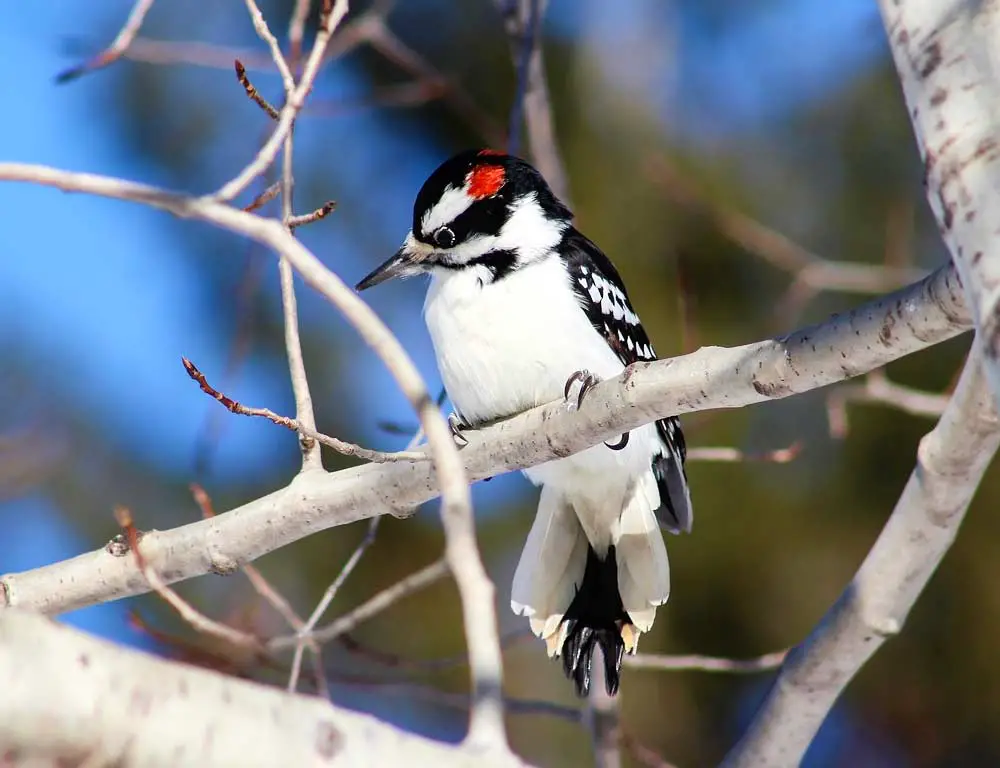
- Scientific name: Leuconotopicus villosus
- Life span: 4 to 8 years
- Size: 7 to 10 inches
- Weight: 1.5 to 3.5 ounces
- Food: Insects, seeds, and berries.
- Wingspan: 13 to 17 inches
- Status: Common
The Hairy Woodpecker is a larger woodpecker with a similar appearance to the Downy Woodpecker but distinguished by its larger size.
It has black and white plumage and a relatively long bill. Found throughout North America, it adapts to various habitats, including forests, parks, and urban areas.
Hairy Woodpeckers forage for insects by pecking and drilling into tree bark. They also eat seeds, nuts, and berries, providing them with a diverse diet.
Their strong, undulating flight and distinctive calls make them familiar sights and sounds in wooded areas. Despite their commonality, they contribute to the biodiversity of forest ecosystems.
11. Black-backed Woodpecker
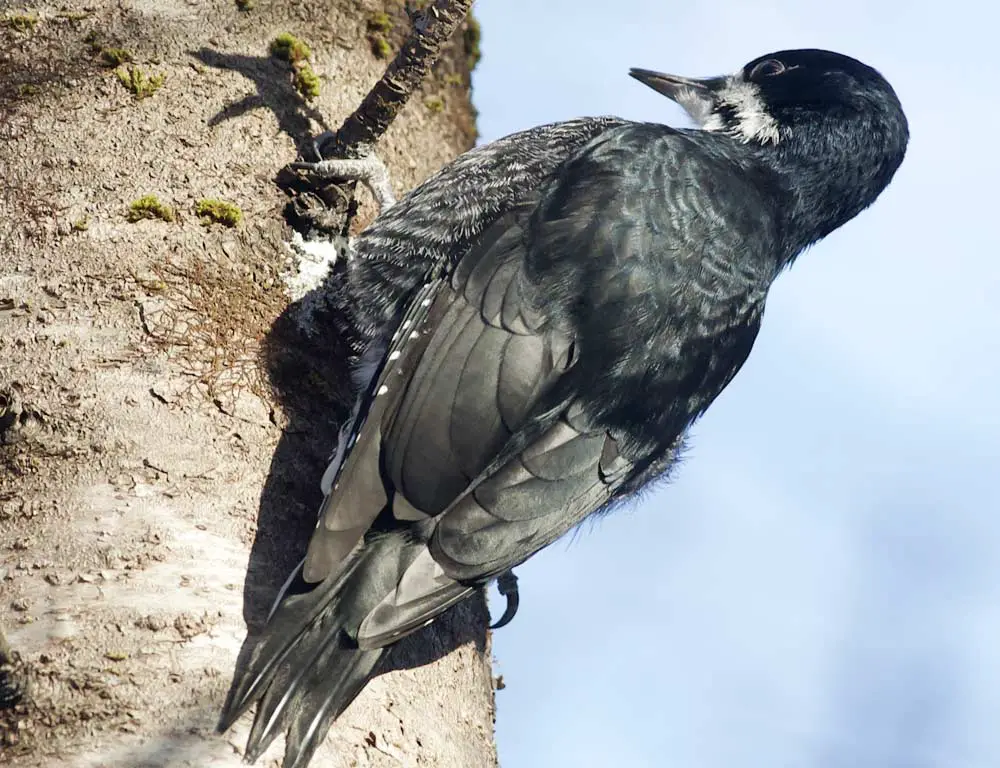
- Scientific name: Picoides arcticus
- Life span: Up to 8 years
- Size: 9 to 10 inches
- Weight: 2 to 3 ounces
- Food: Insects, especially wood-boring beetles and their larvae.
- Wingspan: 16 to 18 inches
- Status: Stable
The Black-backed Woodpecker is aptly named for its black back and white underparts. Males have a yellow cap on the head.
This species is well adapted to boreal and subalpine forests, especially areas affected by wildfires or insect outbreaks, as they primarily feed on insects in dead and decaying wood.
Black-backed Woodpeckers are often associated with recently burned or insect-infested forests, where they find abundant food. They have specialized tongues and bills for extracting wood-boring insects.
Conservation efforts often focus on maintaining habitat diversity, as these woodpeckers play a crucial role in the ecological succession of post-disturbance forests.
Ecological Significance of Woodpeckers Of Ohio
Woodpeckers in Ohio play a vital role in maintaining ecological balance and contributing to the health of their habitats.
These industrious birds are more than just skilled carpenters; they are key players in shaping and preserving the region’s diverse ecosystems.
Pest Control
Woodpeckers are efficient insectivores, such as the Red-naped Sapsucker and the Black-backed Woodpecker. They are crucial in controlling insect populations, particularly those harmful to trees.
By foraging for wood-boring beetles, ants, and other insects, woodpeckers help mitigate potential pest outbreaks that could otherwise damage forests.
Habitat Diversity
The foraging behaviors of woodpeckers contribute to habitat diversity.
Their excavation of cavities in trees provides nesting sites for themselves and creates shelter for other bird species, small mammals, and insects. This diversity supports a more robust and resilient ecosystem.
Seed Dispersal
Woodpeckers, like the Hairy Woodpecker, inadvertently aid in seed dispersal. While foraging for insects, they often knock loose seeds from trees.
These seeds can then fall to the ground, germinate, and contribute to the regeneration of the forest. This process helps maintain the genetic diversity of plant species.
Forest Health Indicator
The presence and behavior of woodpeckers can serve as indicators of forest health. Species like the Black-backed Woodpecker are particularly associated with post-fire or insect-infested areas.
Monitoring these woodpecker populations can provide insights into the overall well-being of the forest ecosystem.
Dead Wood Recycling
Woodpeckers, especially those like the Red-headed Woodpecker, actively excavate cavities in dead or decaying trees.
This process accelerates the decomposition of dead wood, facilitating nutrient recycling in the ecosystem. The resulting cavities also become homes for various wildlife species.
Ecosystem Resilience
Woodpeckers contribute to the overall resilience of ecosystems by adapting to different habitats and ecological conditions.
Their ability to thrive in various landscapes, from mature forests to urban areas, makes them resilient indicators of the adaptability of ecosystems to environmental changes.
Cultural and Educational Value
Beyond their ecological significance, woodpeckers hold cultural and educational value. Observing these birds in their natural habitats fosters an appreciation for biodiversity and the ecosystem’s intricate connections.
This awareness is crucial for promoting conservation efforts and ensuring the continued well-being of Ohio’s natural environment.
Wrapping Up
Ohio’s woodpeckers are not merely birds but ecological architects shaping the state’s diverse habitats.
From pest control to seed dispersal, these industrious avians play pivotal roles in maintaining forest health and promoting biodiversity. Their adaptability and cultural significance underscore the intricate connections within ecosystems.
Observing these feathered carpenters provides a glimpse into Ohio’s avian diversity and serves as a call to appreciate and preserve the delicate balance they contribute to the region’s natural landscapes. Best of luck.